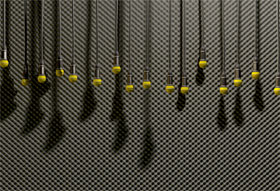Acoustic Foam | Different Types, Effectiveness & Usage

If you’re looking to improve the acoustics of your recording or listening environment, then read on. We’re going to share with you what you need to consider when you’re choosing acoustic foam for improving sound wave delivery.
You’ve probably noticed that there are two different types of acoustic foam. There are the convoluted foam sheets, also known as egg crate, and there’s the flat type with no egg-crate pattern. Both offer slightly different benefits. Read on to discover how to choose the best acoustic foam for your project.
What's your frequency?
One of the primary differences between the two types of acoustic foam is how they handle different frequencies. For example, if you have a low-frequency sound wave, it will be a longer and stronger wave. For best results, this should be handled by a more robust foam that is denser. Overall, you’ll find that the flat foam sheet has better absorbing qualities than the egg crate foam. The flat sheet does a better job at absorbing low frequencies of sound.
In comparison, mid to high-frequency waves are typically shorter and hit at different angles. If you were to install the plain foam, you’d notice that these frequencies can ‘glance off’ and reflect these waves. The egg crate type foam won’t absorb the sound. However, placing your acoustic foam at the right angle can help with absorption.
How effective is Acoustic foam?

The effectiveness of the acoustic foam will depend upon which foam you use, where you place it and the size and shape of the room. There will be natural acoustics of the room which will make the sound specific to that space. If the natural acoustics are already good, you may want to add some egg crate style acoustic foam to help treat the mid to high-frequency sound waves. However, you’ll still need to address the lower and longer sound waves of the bass notes.
If the natural acoustics aren’t too good in the room, then using a plain acoustic foam sheet will help handle the acoustic waves and provide a better soundproofing effect. Consider how a sponge mops up water – a thicker sponge absorbs more.
Which Acoustic foam should you use?
Regarding cosmetics, some sound creators and technicians prefer the egg crate look rather than the plain foam. However, when it comes to performance, it’s probably best to add a bit of both. A soundproofing expert would be able to guide you on where to place them so that you can get the best from your mix.
Easyfoam has over 20 years of experience in the supply of acoustic foam. We supply acoustic foam sheets, acoustic foam tiles & panels and convoluted foam, which is also known as egg crate. We can cut acoustic foam to size too. All our foam is manufactured to exact British Standards in compliance with UL94 HF1 classification plus fire and safety standards.
The acoustic foam at Easyfoam is made to control and reduce flutter echoes, reverberation and reflections and is easy to install with our spray adhesive for foam. Head over to our acoustic foam page to find out more about what we offer or to make your order.
If you have any questions or you’d like to speak to somebody about anything else to do with foam, our delivery service, or ask about bulk discounts, call us now on 0800 3345545 or use our contact form. Our team are very accommodating and enjoy ensuring that customers get the best possible service and prices.
